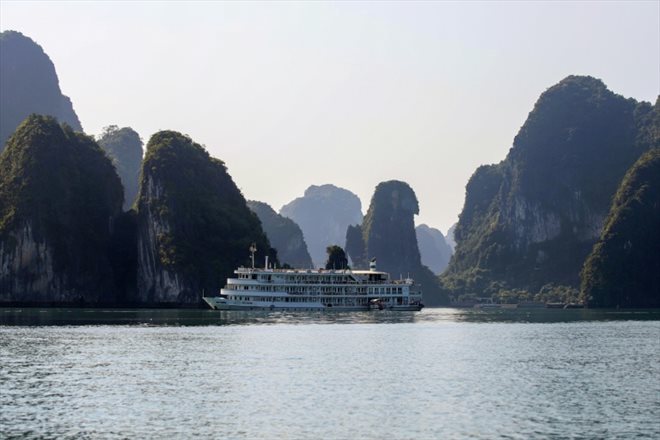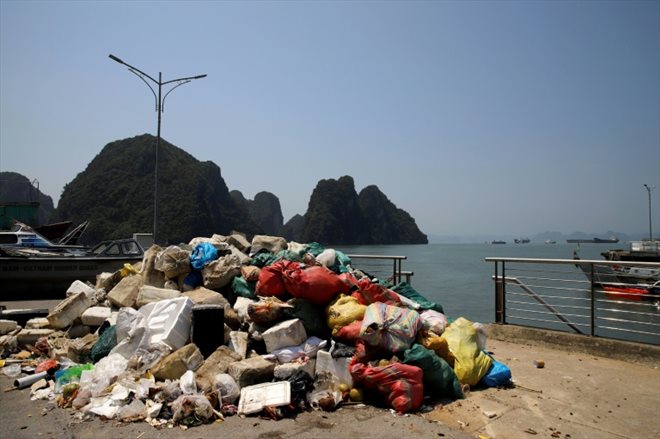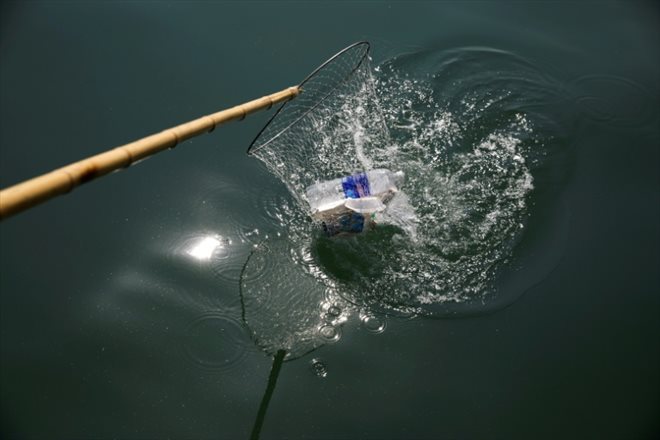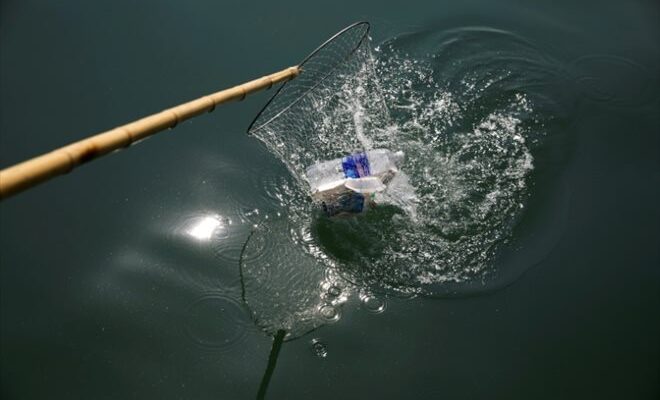A man picks up trash in Ha Long Bay, Vietnam, on May 17, 2023 (AFP/Nam NGUYEN)
Standing on his junk, his eyes squinted by the rays of the rising sun, Vu Thi Thinh scoops up a block of polystyrene floating on the calm waters of the famous Ha Long Bay.
This postcard setting, one of the best known in Southeast Asia, is a victim of its own success. Its beauty is spoiled by debris from buoys, plastic bottles and other soda cans that litter the sea, between the famous limestone blocks.
Ms. Thinh has been traveling the bay on her boat for 10 years to try to contain the impact of human activity on this Vietnamese site listed as a UNESCO World Heritage Site.
“I have to do five to seven boat trips every day to collect everything,” she told AFP.
– Four Olympic swimming pools –
In the past three months, 10,000 cubic meters of waste – enough to fill four Olympic swimming pools – have been collected from the water, according to the administration department of Ha Long Bay.

Workers scoop up trash in Ha Long Bay, Vietnam, on May 17, 2023 (AFP/Nam NGUYEN)
The situation is particularly critical since a recent conflict between fishermen led some of them to dispose of their old polystyrene buoys by throwing them overboard.
Twenty barges, eight boats and a team of ten people were then deployed by the authorities in an emergency to clean everything up, according to state media.
Beyond this specific problem, “Ha Long Bay is under pressure”, recognizes Do Tien Thanh, in charge of the conservation of the site.
In 2022, more than seven million visitors came to admire the spectacular limestone karsts topped with tropical vegetation, on the northeast coast of Vietnam.
The authorities are hoping for eight and a half million this year.
Cable car, amusement park, luxury hotels: the city of Ha Long has bet all its economic development on tourism, but the consequences on the marine ecosystem are already visible.

A boat carrying tourists in Ha Long Bay, Vietnam, on May 17, 2023 (AFP/Nam NGUYEN)
In the bay, there are now only about 100 types of coral left, compared to twice as many originally, according to conservationists, even if the ban on fishing in certain areas has helped to correct the situation .
Dolphin populations have been observed, a first for 10 years.
– “Plastic pollution crisis” –
Single-use plastics have been banned on board tourist boats but human-made waste remains a major concern, as “there are a lot of residential areas near Ha Long Bay”, explains the curator.
And the municipality does not have the means to properly treat all this domestic waste.

A pile of garbage collected in Ha Long Bay, Vietnam, on May 17, 2023 (AFP/Nam NGUYEN)
Some wash up in large numbers on the beaches, in full view of dumbfounded tourists.
Larissa Helfer, a 21-year-old tourist from Germany, agrees that Ha Long Bay is beautiful, but the litter problem is one of the most vivid memories from her trip to Vietnam.
Normally, we should say to ourselves: “Look at the view! Look at the fishing villages”, she underlines to AFP.
But here, “you have to talk about litter, (you say) ‘Oh my god… look at the plastic bottles and things in the sea’. And that makes you sad.”
“My customers read in the media that Ha Long Bay is beautiful, but when they see the many floating garbage, they don’t want to swim or canoe there anymore, and they hesitate to recommend to their friends and family. family to come,” admits Pham Van Tu, a local guide.
Rapid economic growth, urbanization and changing lifestyles in communist Vietnam have led to a “plastic pollution crisis”, according to the World Bank.

Garbage collected with a dip net in Ha Long Bay, Vietnam, on May 17, 2023 (AFP/Nam NGUYEN)
A report released in 2022 found the country to be among the top five ocean polluters in the world, with 3.1 million tonnes of plastic waste produced each year, at least 10% of which ends up in the water.
This figure could more than double by 2030, warns the institution.
On her wooden boat, rubbish piles up around Mrs Thinh who remembers a very different bay when she was a child 50 years ago.
“It had a different feel,” she says.
“Of course, this work tires me and makes me angry,” she admits. “But we have to do it.”
© 2023 AFP
Did you like this article ? Share it with your friends with the buttons below.




